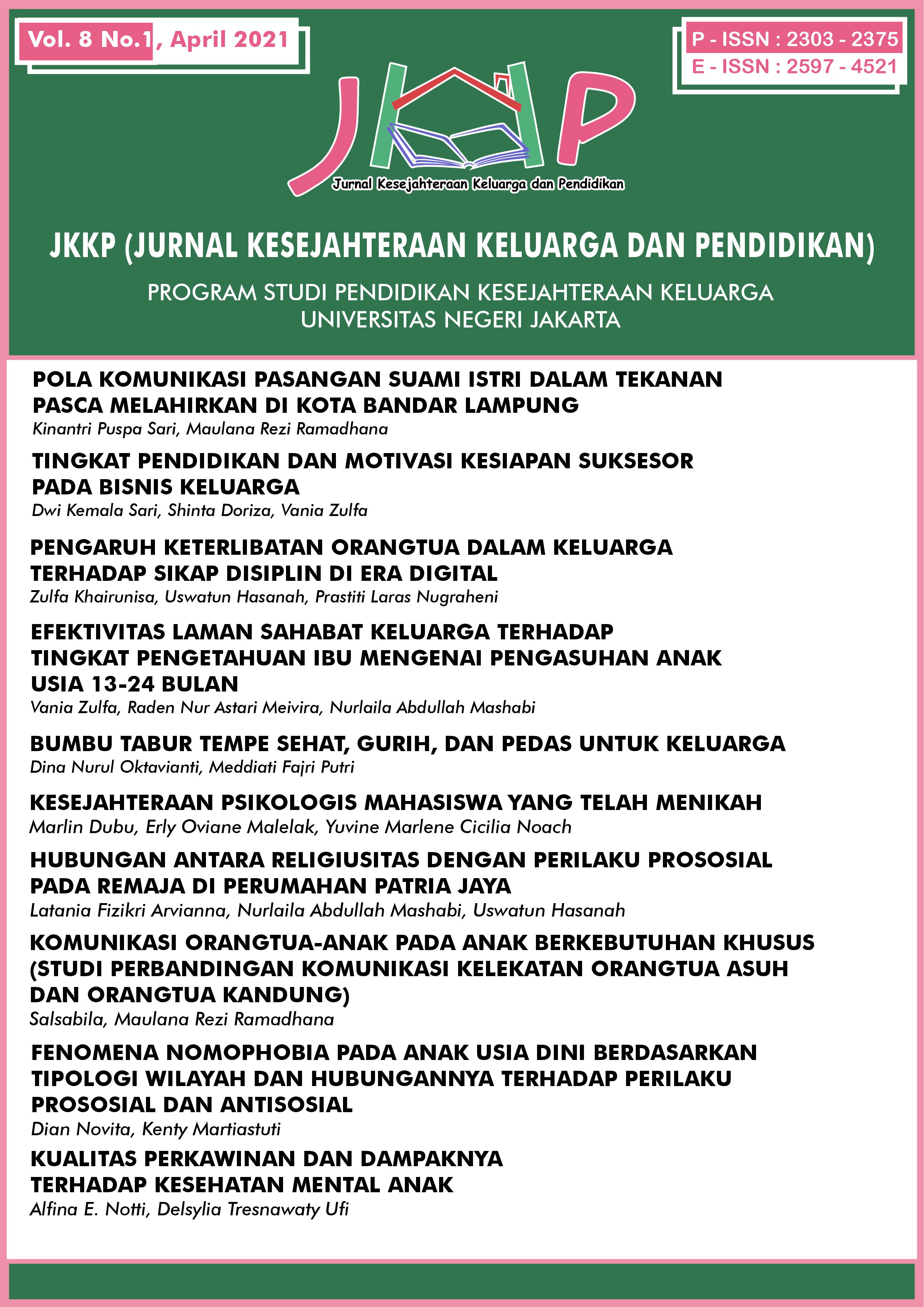FENOMENA NOMOPHOBIA PADA ANAK USIA DINI BERDASARKAN TIPOLOGI WILAYAH DAN HUBUNGANNYA TERHADAP PERILAKU PROSOSIAL DAN ANTISOSIAL
DOI:
https://doi.org/10.21009/JKKP.081.09Keywords:
early childhood, nomophobia, social behaviorAbstract
Abstrak
Penelitian ini bertujuan untuk mengidentifikasi fenomena nomophobia pada anak usia dini di wilayah perdesaan dan perkotaan, menganalisis perbedaan perilaku nomophobia dan perilaku sosial antara kedua wilayah, serta menganalisis hubungan perilaku nomophobia terhadap perilaku sosial. Penelitian ini dilakukan di dua wilayah yaitu di Kabupaten Kuningan (representatif wilayah perdesaan) dan Kota Depok (representatif wilayah perkotaan) dengan responden masing-masing sebanyak 50 orang, sehingga total responden adalah 100 orang. Data yang dikumpulkan dari penelitian ini adalah perilaku nomophobia yang menggunakan instrumen NMP-Q (Yildirim,2015) dan perilaku sosial diukur berdasarkan dimensi yang dikembangkan oleh Hurlock (1978) yang terdiri atas perilaku prososial dan antisosial. Melalui uji independent sample t-test, hasil penelitian menunjukkan tidak ada perbedaan signifikan pada perilaku nomophobia antara wilayah perdesaan dan perkotaan. Skor rata-rata perilaku nomophobia di perdesaan adalah 35,61 sedangkan di perkotaan adalah 35,72 yang termasuk kategori rendah. Perilaku sosial di kedua wilayah sebagian besar menunjukkan kategori tinggi (64%) dan tidak ada perbedaan perilaku sosial secara umum baik di perdesaan maupun perkotaan. Hasil uji korelasi menunjukkan tidak adanya hubungan signifikan antara perilaku nomophobia dan perilaku sosial namun koefisien korelasi negatif yaitu -0,085 menjadi indikasi bahwa semakin tinggi perilaku nomophobia maka akan semakin rendah perilaku sosial anak usia dini. Hal ini perlu mendapat perhatian bersama, mengingat dampak buruk yang dapat ditimbulkan dari adanya fenomena nomophobia terutama pada anak usia dini.
Kata Kunci: anak usia dini, nomophobia, perilaku sosial
Nomophobia Phenomenons in Early Childhood based on Regional Typology and Its Relationship to Prosocial and Antisocial Behaviors
Abstract
This study aims to identify the phenomenon of nomophobia in early childhood in rural and urban areas, to analyze differences in nomophobic behavior and social behavior between the two regions and to analyze the relationship between nomophobic behavior and social behavior. This research was conducted in two areas, namely Kuningan District (rural area representative) and Depok City (urban area representative) with 50 respondents each, so that the total number of respondents was 100 people. The data collected from this study were nomophobic behavior using the NMP-Q instrument (Yildirim, 2015) and social behavior was measured based on the dimensions developed by Hurlock (1978) which consisted of prosocial and antisocial behavior. Through the independent samples t-test, it was found that the results of the study showed no significant difference in nomophobic behavior between rural and urban areas. The average score of nomophobic behavior in rural areas is 35,61, while in urban areas it is 35,72 which is in the low category. Most of the social behavior in the two regions shows the high category (64%) and there is no difference in social behavior in general, both in rural and urban areas. The results of the correlation test showed that there was no significant relationship between nomophobic behavior and social behavior, but the negative correlation coefficient, namely -0,085, is an indication that the higher the nomophobic behavior, the lower the social behavior of early childhood. This needs mutual attention, considering the bad effects that can be caused by the phenomenon of nomophobia, especially in early childhood.
Keywords : early childhood, nomophobia, social behavior
Downloads
Published
Issue
Section
License
Authors who publish with this Journal agree to the following terms:
- Author retain copyright and grant the journal right of first publication with the work simultaneously licensed under a creative commons attribution licensethat allow others to share the work within an acknowledgement of the work’s authorship and initial publication of this journal.
- Authors are able to enter into separate, additional contractual arrangementfor the non-exclusive distribution of the journal’s published version of the work (e.g. acknowledgement of its initial publication in this journal).
- Authors are permitted and encouraged to post their work online(e.g. in institutional repositories or on their websites) prior to and during the submission process, as it can lead to productive exchanges, as well as earlier and greater citation of published works.
Users/public use of this website will be licensed to CC BY SA
![]()







